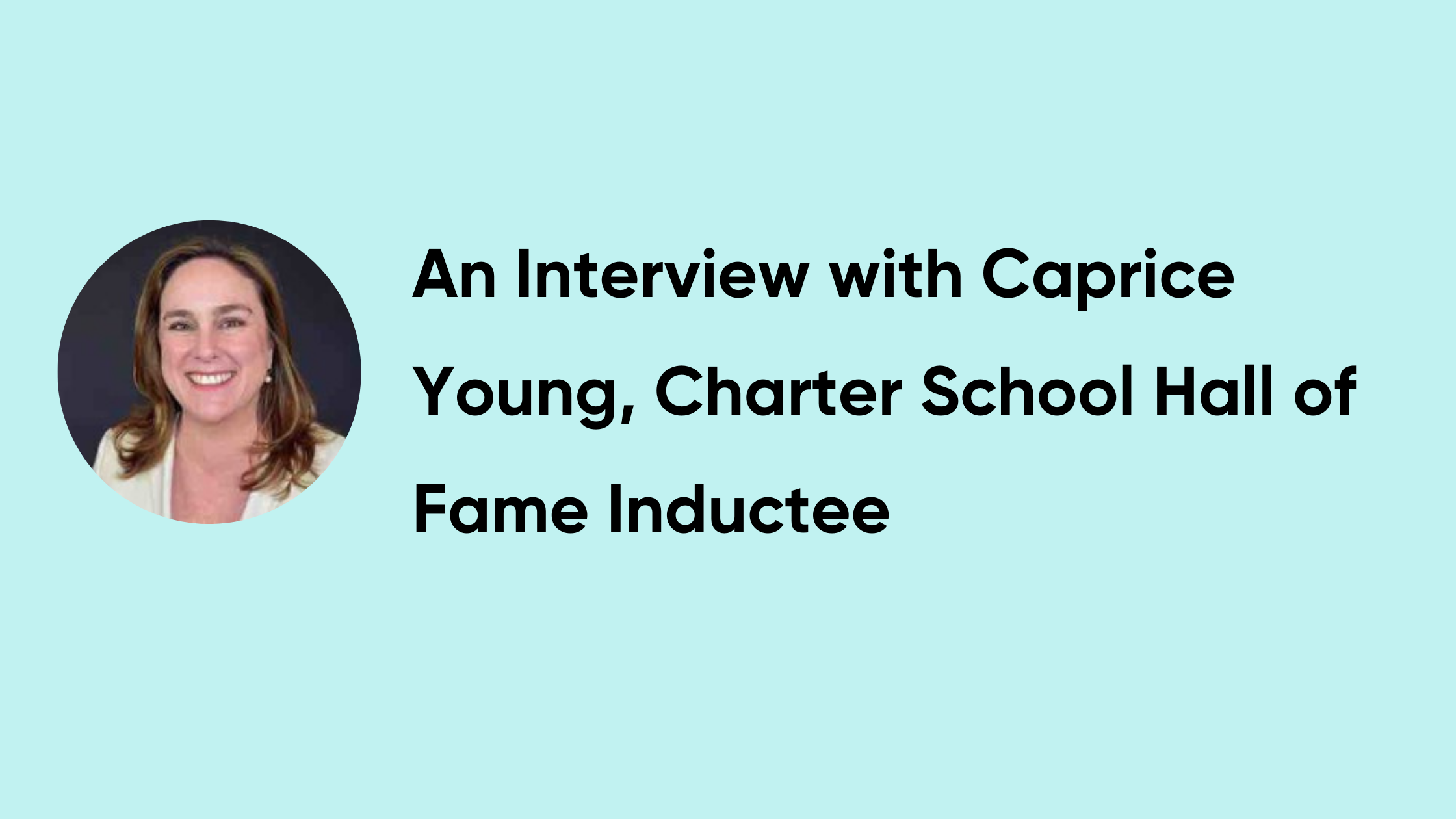
Governing for Growth at Every Stage, Part 1

An Interview with Caprice Young, Charter School Hall of Fame Inductee.
When I thought about launching this series, I couldn’t think of anybody better than Caprice Young to help introduce this concept of governing for growth.
For at least 20 years, Caprice has done just about every kind of governing you can imagine — from founding the California Charter School Association to serving on the LA USD school board and then chairing that board.
In fact, she’s been serving on boards since the age of 14. Today, she’s on the Fordham Foundation Board and two education-related private sector boards.
As a CEO, she’s reported to a lot of boards. That includes charter school boards that were in crisis and others that have been extraordinarily healthy.
As a charter trustee, she’s served on multiple charter boards — both startup and more seasoned. As Caprice put it, she’s “probably seen the toughest and some of the best.”
And, in her current role at Learn4Life, Caprice is leading a network of charters educating 45,000 former high school dropouts in 85 locations in California, Ohio, and Michigan. For Caprice, Learn4Life is a thrilling chance “to work with this population of kids because they feel like the brothers and sisters that [she] grew up with and the foster family where [she] was raised.”
And what’s more, they’ve set this big hairy goal of, by 2030, educating 1 million of these kids. So, from a governance perspective, it’s very likely that five years from now Learn4Life won’t have the 20 boards they do now, but 100. That’s why they’ve invested in BoardOnTrack for their boards at this critical stage. Caprice knows how vital the right infrastructure is scaling at this level.
Recently Caprice and I spoke and we got a really far-reaching perspective on the topic of governing for growth, from multiple angles.
{MARCI} Caprice, talk a little bit about your career journey — the different professional things that led you to those different boards.
{CAPRICE} I’m probably one of the few people on this call that was not raised as an educator.
Out of college, I worked with high-risk kids but couldn’t pay the rent. So I ended up going into finance and budgeting, and then technology, and served as assistant deputy mayor for the mayor of Los Angeles for a little while, then got crazy and ran for the school board in Los Angeles.
Some people join the PTA. I run for the school board. I served for four years on the school board in Los Angeles.
And when I was leaving the school board, the charter folks came to me and said, ‘hey, we really need to have a statewide organization that unifies all of the charters so that we can have a real voice and go from being just a network of schools to being something that is a real movement.’
So I had the pleasure of founding the California Charter Schools Association and really fell in love.
After I left the Charter Schools Association, I ran a company that engaged in online learning;. I turned around two charter school management organizations.
{MARCI} So let’s dive in…a really big picture question that gets asked a lot in the charter movement: Does governance actually even matter? If people think they can point to great charter schools or charter school networks that don’t have a great board, does governance actually matter?
{CAPRICE} I’ve spent a lot of time within the turnaround space and I can tell you that the number one issue with every one came back to governance and having a really tight governance team.
The executive leadership and the people who are on the board are really critical. Without that, you can get good, but you can’t get great.
And in the charter school world, we often say, ‘governance is a necessary evil and I really just want my board to stay out of my business and just let me run the school.’ And it’s easy to do that because everything is so overwhelming when you’re running a school on a day-to-day basis.
However, if you have a really well-trained board that knows where they fit in, well, they can be a huge asset.
I hope everyone will see governance as a potential asset; the board members as people who have real skills and talents that can be brought to bear on really strategic issues. I hope everyone will move towards having board process that are meaningful and targeted at the right level.
{MARCI} During the founding of the charter movement, the first few decades were really about the launch. Now, when you look forward to the next 20 years, how do you see boards fitting into the movement?
{CAPRICE} Well, when you start a startup, a small charter school that’s community based, which is the vast majority of our charter schools, a lot of times the boards are community volunteers who know the community well but may never have served on a board before.
There’s a lot of training that needs to happen.
It’s also training for the CEO or the executive director or the principal, too, because the head of the school has to be deeply engaged in that board process.
When you get a healthy board process [in place], you can have deep traditions in your school around governance that lead to long-term systemic health.
You really don’t know that a charter school is successful until after the founders have left.
The boards are the ones that take them through that process and into the next generation of leadership. And the leaders who have neglected their board and then eventually get to a point where it’s time to leave, leave their charters in a real crisis.
That’s probably the most important thing that’s starting to happen right now.
Because, as the charter school movement gets to the 25- and 30-year mark, we have people who are in their twenties when they opened their charter schools and now they’re ready to retire. But they’re finding that the whole organization is dependent on them.
{MARCI} Many of those founders have grown their organizations so large that it’s not the single site. Just one site is really different than governing 10 sites or more than 80. Talk about what it means to have the right people and the right infrastructure and the right focus; as you grow.
{CAPRICE} Getting the right people on the bus is absolutely key. You have to have human beings on the board who have skill sets that are useful to the organization.
And you want to have people on the board who have skill sets related to the communities in which the schools are located.
Because one of the biggest challenges as you grow from one neighborhood to another or even to another city or another state, is that in order to be successful, you have to have the leadership of the people that you’re serving, engaged in the decision making.
It’s always a challenge to find the right mix of human beings to be able to be on the board. But ideally, you would have people who are from or still live in the neighborhoods that you’re serving, and possibly have someone who is an attorney on the board, someone who has some financial background, people who have run large organizations on the board as well.
And that often means you end up getting to have a fairly large board by the time you get all of the things you need. And that’s when things get a little wild.
It’s better to have a small board of five-to-seven people who are very diverse and work together really well. Or, a very large board with a small executive committee that does a lot of the day to day work and then engages the full board in more of the long-term strategic issues.
{MARCI} What about temperament or other kinds of qualities? You can have someone who’s a really good lawyer, but they may not be the right lawyer for your board.
{CAPRICE} Here’s the thing. A lot of board members focus on what they know.
So if you have a lawyer on the board, the lawyer is going to focus on the legal issues. If you have somebody who has been in planning or construction, they’re going to focus on the facilities issues. And most of the time, that’s a really good thing because you’re getting that expertise in that area.
As people focus on what they know, it’s also important to have them focusing on what is needed.
And that’s where having really good processes for the board — mutually deciding what issues they’re going to focus on. And on an ongoing basis, having a process for knowing what items are going to come up on the agenda and what information the board is going to receive about it.
{MARCI} And then what would you say about having the right infrastructure in place for your board?
{CAPRICE} It’s so much easier to have a really great involved board if they have regular processes that are predictable.
So… they know that they’re going to get their board agenda 72 hours before their board meeting; they know the kinds of issues that are going to come before them.
I call that the infrastructure because it’s all about the processes and the infrastructure of holding the board meeting.
Also, I’ll give a plug for BoardOnTrack here: It’s really important to be able to manage all the documents that board members need in a way that is easy for them to handle. So that key documents are easy for them to find; so that they can get things electronically or in hard copy.
All of that infrastructure makes it easy to focus on the concrete policy issues that boards have to have so that they don’t have to spend all of their time on things related to, ‘Gosh, I didn’t get the right document.’
An awful lot of charter schools, as they start to replicate or grow, they’re forced to have multiple boards.
They may be similar schools using the same model that was invented in the first school. But as they go to future schools, they have to have separate board meetings and separate nonprofit entities for those other boards.
In the case of Learn4Life, for example, we have 20 charter boards. All of them are locally controlled and independent. However, they also all share in the infrastructure and are managed in a similar way because we have similar schools and if we didn’t have the infrastructure, we wouldn’t be able to manage a 20 boards. That would be crazy.
{MARCI} And how should the board’s focus should change over time, especially as you’re growing? What are your lessons learned there?
{CAPRICE} This is one of the hardest things for a board because when you’re in the startup mode, everybody’s pitching in, so your board members probably were helpful.
In writing the charter petition, they were probably helpful in reaching out to the authorities that were going to approve the charter. In some cases, the board members even left the board and became staff of the charter schools.
In the first year especially, you’re going to see a board that is really all hands on deck. When I was on the board of a startup charter school, I even brought my pickup truck to carry the tables and chairs from Ikea over to the school.
But then, as you get to replication and starting more schools or adding more grades, the issues that boards are dealing with change.
They’re less about, ‘how fast can we hire really great teachers’ and more about ‘how do we build a leadership pipeline so that we can train all the new people who are coming in.’
And a small charter school may have a budget of under a million dollars. But a group of charter schools can easily have a budget of more than $50 million.
If your board members are used to the family checkbook, making that shift to $50 million can be hard. I’ve been on boards where we’ve had four-hour conversations over $2,000 change orders.
Having your board grow in their level of sophistication as your organization grows is really key. And some boards can’t make the transition.
Some board members need to frankly get off the board sometimes. Or switch roles; switch to an advisory board or something that’s related to the individual school as opposed to being on a fiduciary board that’s handling tens of millions of dollars.
One of the things that can kill a charter is if they have board members that are unwilling to change what they control as the organization grows. And it’s not easy peasy. An external support person can be really helpful.
Governing for growth requires an evolution of your board and its infrastructure.
Governing for growth is essential.
Between Caprice’s decades of experience, and my own working with hundreds of charter boards nationwide, two things are clear to us: the mission demands that we focus on growth. And governing for growth is central to successful, sustainable charter growth.
It’s about having the right people, in the right roles; following the right processes to enable them to contribute to the fullest. It’s about accepting when it’s time for founding board members to make room for the right trustees for where the organization is, and where it’s going.
Without the right infrastructure in place, it’s simply not possible to sustain even incremental growth, let alone the sort of explosive growth that Caprice expects to lead with Learn4Life in the next five years.
In our next installment of this two-part series, we’ll look closely at the CEO’s role in governing for growth — and how to avoid some of the community’s most common mistakes. Check out part two coming soon.

Marci Cornell-Feist
With more than two decades in the field, Marci Cornell-Feist is a national expert on charter school governance whose work has helped more than 500 charter schools nationwide. Marci created BoardOnTrack to implement the most effective strategies and practices of her many clients, and as a means of spreading this information to a wider audience of charter schools. She's also a co-founder of The Achievement Network, which helps schools use data-driven strategies to raise student achievement, and previously founded and led the charter school consultancy, Meetinghouse Solutions.
